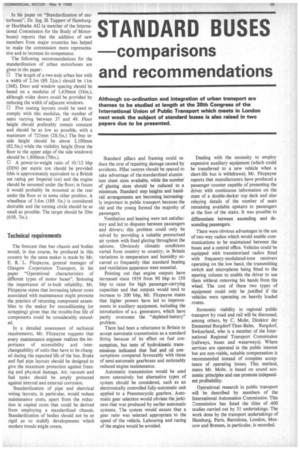STANDARD BUSES
Page 61

If you've noticed an error in this article please click here to report it so we can fix it.
comparisons and recommendations
Although co-ordination and integration of urban transport are themes to be studied at length at the 38th Congress of the International Union of Public Transport which meets in London next week the subject of standard buses is also raised in two papers due to be presented.
Standard pillars and framing could reduce the cost of repairing damage caused by accidents. Pillar centres should be spaced to take advantage of the standardized aluminium sheet sizes available, while the number of glazing sizes should be reduced to a minimum. Standard step heights and handrail arrangements are becoming increasingly important in public transport because the old and the young formed the majority of passengers.
Ventilation and heating were not satisfactory and led to disputes between passengers and drivers; this problem could only be solved by providing a suitable pressurized air system with fixed glazing throughout the saloons. Obviously climatic conditions varied from country to country; in Britain variations in temperature and humidity occurred sa frequently that standard heating and ventilation apparatus were essential.
Pointing out that engine outputs have increased since 1959 from 90 bhp to 150 bhp to cater for high passenger-carrying capacities and that outputs would tend to increase to 200 bhp, Mr. Fitzpayne states that higher powers have led to improvements in auxiliary equipment, including the introduction of a.c. generators, which have partly overcome the "depleted-battery" problem.
There had been a reluctance in Britain to accept automatic transmission as a standard fitting because of its effect on fuel consumption, but tests of hydrokinetic transmissions indicated that fuel and oil consumptions compared favourably with those of semi-automatic gearboxes and noticeably reduced engine maintenance.
Automatic transmission would be used more extensively but alternative types of system should be considered, such as an electronically controlled fully-automatic unit applied to a Pneumocyclic gearbox. Automatic gear selection would obviate the jerkiness that was produced by earlier automatic systems. The system would ensure that a gear ratio was selected appropriate to the speed of the vehicle. Labouring and racing of the engine would be avoided. Dealing with the necessity to employ expensive auxiliary equipment (which could be transferred to a new vehicle when a short-life bus is withdrawn). Mr. Fitzpayne reports that manufacturers have produced a passenger counter capable of presenting the driver with continuous information on the state of a double-decker top deck and also relaying details of the number of seats remaining available upstairs to passengers at the foot of the stairs. It was possible to differentiate between ascending and descending passengers.
There were obvious advantages in the use of two-way radios which would enable communications to be maintained between the buses and a central office. Vehicles could be equipped with transistorized radios fitted with frequency-modulated-tone receivers operating on the low band, the transmitting switch and microphone being fitted to the steering column to enable the driver to use them without removing his hands from the wheel. The cost of these two types of equipment could only be justified if the vehicles were operating on heavily loaded routes.
Economic viability in regional public transport by road and rail will be discussed, among others, by C. Mohr, Direktor der Emmental-Burgdorf-Thun-Bahn, Burgdorf, Switzerland, who is a member of the International Regional Transport Commission (railways, buses and waterways). Where services are operated in the public interest but are non-viable, suitable compensation is recommended instead of complete acceptance of operating losses. This method, states Mr. Mohr, is based on sound economic principles and can promote independent profitability.
Operational research in public transport will be described by members of the International Automation Commission. This Commission has listed the titles of 400 studies carried out by 31 undertakings. The work done by the transport undertakings of Hamburg, Paris, Barcelona, London, Moscow and Bremen, in particular, is recorded.


















































































































